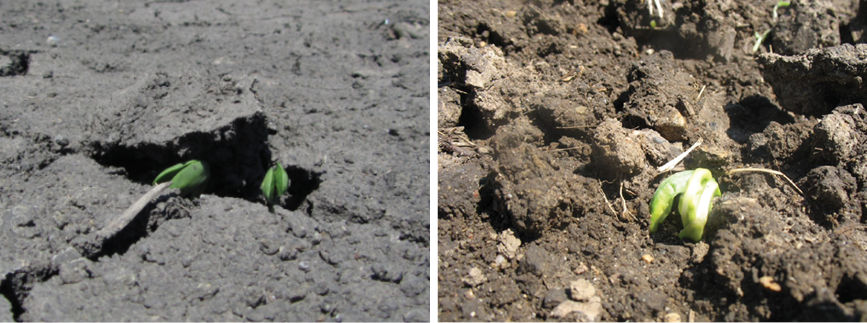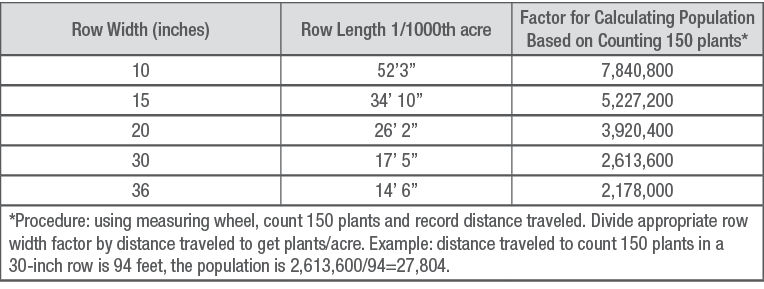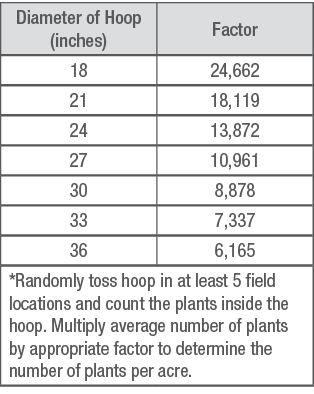5 MIN READ
Managing Soil Crusting with a Rotary Hoe
March 27, 2021
Soil Crusting
Soil crusting can occur when soils begin drying after a heavy rainfall or flooding. Soil conditions most prone to crusting are soils that are fine textured, low in organic matter, have little to no surface residue, and conventionally-tilled. Hot, windy conditions can cause soils to crust rapidly. Residue can help reduce the impact raindrops have on the soil and reduce the potential for soil crusting. Therefore, conservation tillage methods and planting can be beneficial for fields prone to crusting. Fields with a tendency to crust should be monitored closely for emergence after planting and after heavy rains. A tape measure, measuring wheel, or hoop should be used to count emerged plants (Tables 1 and 2).

Seed Emergence Problems Associated with Soil Crusting
Potential crop populations can be adversely affected by crusting when germinating seedlings are unable to penetrate through the crust (Figure 1). The penetrating structure of corn is the coleoptile. If it is unable to break through the crust, the seedling may become “corkscrewed” in appearance and leaf out under the surface. Seedlings that leaf out under the surface may die or become stunted if they do emerge. Soybean seeds reach the surface by elongation and extension of the hypocotyls which carries the cotyledons to the surface. Crusted soil can cause the hypocotyls to crack or break off, which can result in the death of the seedling or, at the very least, a weak and potentially diseased seedling. Future environmental conditions can help or hinder emergence through crusted soils. Light showers that moisten the crusted layer accompanied by warm temperatures and low wind conditions may allow the seedlings to emerge. High temperatures and strong winds can “bake” the soil making it even harder for seedlings to penetrate. If the environment is cold and wet, seedlings may perish due to seedling diseases. Seed treatments with systemic properties may be beneficial in reducing the opportunity for seedling diseases to develop.
Rotary Hoeing as a Potential Rescue Treatment
Rotary hoes can be effective tools for fracturing crusted soils and allowing seedlings to emerge (Figure 2). Emerged populations, seedlings, and soil conditions should be evaluated when determining if a rotary hoe should be used. Rotary hoes can damage seedlings; therefore, the loss from rotary hoe use (generally 1 to 2% in corn) should be observed to see if damage is greater than expected.1 One way to observe for potential rotary hoe damage is to place different colored flags at emerged and non-emerged seedlings within a designated area prior to operating the hoe. After passing through the area, an observation should be made to determine the amount of any damage. Running the hoe in the afternoon may also reduce the risk of damaging seedlings as they are more pliable than compared to morning hours.2 Conversely, the soil surface in the afternoon may be harder to fracture, than in the morning.
When using a rotary hoe, the soil should be moist to dry. If the soil is too wet, the hoe is more likely to just punch holes in the soil and not fracture it so the seedlings can emerge. A smaller tractor can be used to pull the hoe because it usually does not require a lot of horsepower and can reduce the potential for creating compaction. This is an economical means to alleviate soil crusting as well. Fuel costs for rotary hoeing are 0.20 gallons of diesel per acre. 1 Tractor speed should be in the range of 8 to 10 miles per hour as higher speeds generally increase fracturing.3 The hoe should be set to penetrate just deep enough to break the crust; deeper tilling increases the potential for damaging the seedlings. The process should be completed with the rows as driving over the rows and seedlings increases the opportunity for compaction around the seedlings.3 After hoeing a strip (possibly one marked with flags), an observation should be made to determine how successful the operation has been. If it appears that the hoe is going too deep and digging out seedlings, down pressure or weight on the hoe should be reduced. If the crust is not being fractured and the soil is not too wet, down pressure or weight on the hoe should be increased.
Observations should be made across different soil types if they vary significantly within a field. A 3 to 5% loss of plants due to hoeing may warrant traveling at a slower speed.1 If soybean cotyledons are being knocked off by the operation, adjustments should be considered as lost cotyledons generally indicate the seedling will die. Seedling corn is generally more forgiving; however, stoppage or adjustments should be considered if significant damage or uprooting occurs.
Rotary Hoe Weed Control
A rotary hoe can be used to help control seedling weed growth when the crop is in a seedling stage, particularly if the environment has been too dry to allow for the activation of preemergence herbicides. Weeds should be very small, possibly not observable on the surface. Scraping the surface with a tool or shoe may expose seedling weeds that can be removed by the hoe and expose them to wind and sun to dry them out. As discussed above, the crop should be observed to determine if too much damage from hoeing occurs. Weeds that can be seen from the road are probably too large to be controlled with a rotary hoe operation.

Table 1. Determining stand counts based on row width and number of plants in 1/1000th acre or by counting 150 plants within a row width.4,6

Table 2. Hoop method for determining soybean and other solid seeded crops.*4,5

Sources
1 Al-Kaisi M. 2012. Pay attention to soil crusting after heavy rain events. Integrated Crop Management News. Iowa State University. http://crops.extension.iastate.edu.
2 Staton M. 2018. Improving soybean emergence in soils prone to crusting. Michigan State University Extension. http://canr.msu.edu.
3 Hanna M., Al-Kaisi M., and Tidman M. 2001. Use the rotary hoe for soil crusting. Integrated Crop Management. ICM-2001-IC-486 (8). Iowa State University. http://crops.extension.iastate.edu.
4 Hoeft, R.G., Nafziger, E., Johnson, R. and Aldrich, S. 2000. Modern corn and soybean production. First Edition. MCSP Publications.
5 Nielsen, R.L., Young, B.G., Krupke, C.H., Gerber, C.K., Telenko, D., Camberato, J.J., Ackerson, J.P., Bonkowski, J., Obermeyer, J.L., Rorick, J.D., Humberg, L.A., Zhang, L., Zimmer, M., Casteel, S.N., Brouder, S., Creswell, T., Johnson, W.G. 2012 Corn & Soybean Field Guide. ID-179. Purdue Extension.
6 Nafziger, E. 1997. Early planted corn starting to emerge. No. 6. May 2. the Bulletin. University of Illinois. http://bulletin.ipm.illinois.edu.
Additional sources:
Duiker, S.W. 2017. Soil Crusting. Penn State Extension. http://extension.psu.edu.
Web sources verified 03/05/2021.
4007_S1